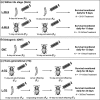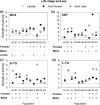Divergent immune priming responses across flour beetle life stages and populations
- PMID: 30128134
- PMCID: PMC6093166
- DOI: 10.1002/ece3.2532
Divergent immune priming responses across flour beetle life stages and populations
Abstract
Growing evidence shows that low doses of pathogens may prime the immune response in many insects, conferring subsequent protection against infection in the same developmental stage (within-life stage priming), across life stages (ontogenic priming), or to offspring (transgenerational priming). Recent work also suggests that immune priming is a costly response. Thus, depending on host and pathogen ecology and evolutionary history, tradeoffs with other fitness components may constrain the evolution of priming. However, the relative impacts of priming at different life stages and across natural populations remain unknown. We quantified immune priming responses of 10 natural populations of the red flour beetle Tribolium castaneum, primed and infected with the natural insect pathogen Bacillus thuringiensis. We found that priming responses were highly variable both across life stages and populations, ranging from no detectable response to a 13-fold survival benefit. Comparing across stages, we found that ontogenic immune priming at the larval stage conferred maximum protection against infection. Finally, we found that various forms of priming showed sex-specific associations that may represent tradeoffs or shared mechanisms. These results indicate the importance of sex-, life stage-, and population-specific selective pressures that can cause substantial divergence in priming responses even within a species. Our work highlights the necessity of further work to understand the mechanistic basis of this variability.
Keywords: Tribolium castaneum; ontogenic immune priming; transgenerational immune priming; variability; wild populations; within‐generation immune priming.
Figures





References
-
- Abdel‐Razek, A. S. , Salama, H. S. , White, N. D. G. , & Morris, O. N. (1999). Effect of Bacillus thuringiensis on feeding and energy use by plodia interpunctella (Lepidoptera: Pyralidae) and Tribolium Castaneum (Coleoptera: Tenebrionidae). Canadian Entomology, 131, 433–440.
-
- Contreras‐Garduño, J. , Rodríguez, M. C. , Rodríguez, M. H. , Alvarado‐Delgado, A. , & Lanz‐Mendoza, H. (2014). Cost of immune priming within generations: Trade‐off between infection and reproduction. Microbes and Infection, 16, 261–267. - PubMed
LinkOut - more resources
Full Text Sources
Other Literature Sources

